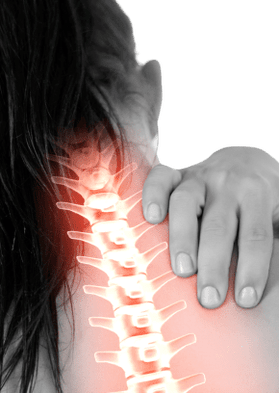The total incidence of osteochondrosis of the cervical spine is approx. He is the "youngest" and often affects people under the age of 30. The disease develops gradually, progressing slowly but steadily. It can usually be asymptomatic in the early stages of developing osteochondrosis of the neck and becomes a random finding on X-ray.

Causes of osteochondrosis
The disease manifests itself as a dull painful pain in the chest, under the shoulder blades, in the shoulder, numbness and the appearance of "goose hills" appearing in the chest, as stiffness of movements. Often the pain is belt-like, angina pectoris, accompanied by unpleasant painful feelings in the stomach and shortness of breath. Sometimes short-term acute pain is observed.
Causes of vertebral disc destruction and compression of spinal nerve endings can include adolescent scoliosis, sedentary lifestyle, obesity, the same type of load on the spine, and regular long-term sitting.
Cervical spine osteochondrosis: symptoms
The most important, first, and most common symptom of osteochondrosis of the cervical spine is pain. Increases when the head is bent or rotated. Depending on the location of the abnormal focus, pain may be given to the back of the head, under the shoulder blade, or in the arm.
Depending on the location of the abnormal focus, pain may be given to the back of the head, under the shoulder blade, or in the arm.
It can be constant, it hurts. It can happen from time to time, but as the disease progresses, one becomes more and more concerned. The pain is also sharp, shot. This is a symptom of exacerbation of cervical osteochondrosis that may manifest after hypothermia in the body.
The movement of the head is usually difficult. This is due to the constant tension in the muscles in the collar zone and neck. When you lean forward or turn your head, you often hear a crackle.
In the later stages of osteochondrosis of the neck, a person cannot hold his head for a long time. Sometimes he is unable to turn or tip over without feeling severe pain. The patient tries to support his head with his hands or tries to put himself in a comfortable position to alleviate his suffering.
Vertebral artery syndrome

This group of symptoms occurs due to displacement of the vertebral artery due to displacement of the vertebral disc, overgrown cartilage, or tense muscles. The syndrome is a complex of symptoms including cervical migraine, confusion, and increased blood pressure.
Cervical migraine is a headache that results from a decrease in blood flow and a lack of oxygen to the tissues. The pain is often one-sided. Above all, his head hurts. Possible irradiation of the ears, eyes or forehead.
Sometimes hearing loss occurs and the ears start ringing. Possible visual impairment. The eyes are double, the "flies flicker" in front of the eyes. The scalp can be so painful that you can’t even touch it. Headaches associated with osteochondrosis of the cervical spine are often accompanied by nausea and vomiting.
A common symptom of cervical osteochondrosis and compression of the vertebral artery is an increase in blood pressure. But cervical spine osteochondrosis and hypertension are not always related. It should not be forgotten that an increase in pressure can be observed in many people in old age.
The doctor can only determine that high blood pressure is a complication of the disease after studying the history of osteochondrosis of the cervix. If you have a history of recurrent arterial hypertension accompanied by palpitations and fear of death, this is probably one of the symptoms of compression of the vertebral artery. If the increase in pressure occurred gradually and frequent hypertensive crises were not observed, the patient is likely to have hypertension that is not associated with osteochondrosis.
Impaired consciousness occurs when the brain does not have an adequate blood supply. Drowsiness, dizziness, decreased rate of response to external stimuli. Short-term loss of consciousness occurs.
Rehabilitation after spinal stroke
What are the most dangerous symptoms of cervical osteochondrosis? Undoubtedly, this is a spinal stroke - the death of part of the spinal cord due to a complete lack of blood flow in the constricted vessels. It always leads to disability, causing paresis and paralysis. Fortunately, spinal strokes are rare.
Heart syndrome
Symptoms of worsening osteochondrosis of the cervical spine include heart pain. It occurs due to pinching of the posterior roots of the fourth spinal nerve. In fact, heart pain can be attributed to radical syndrome. But this symptom is specific and therefore isolated as a separate syndrome.
Heart pain in osteochondrosis may mimic angina pectoris or myocardial infarction. But when a patient seeks medical help, the competent physician can immediately rule out heart disease based on the patient’s symptoms and complaints.
- First, the presence of other symptoms of osteochondrosis of the cervical vertebrae in the patient already leads the practitioner to the idea that heart pain may be caused by spinal problems;
- Second, the pain is not as strong and sharp as in a myocardial infarction and is not accompanied by fear of death. This does not involve physical activity, unlike the attack of angina pectoris;
- Third, such pain is quite long and does not resolve or subside after ingestion of nitroglycerin;
- Fourth, the pain increases as the head is turned or tilted, which is not observed in "real" heart disease.
Radical syndrome
Radical syndrome combines the signs of cervical osteochondrosis that develop as a result of compression of the roots of the spinal nerves. Depending on the level of the sting, different symptoms of intervertebral osteochondrosis of the cervical spine may develop.
Compression of the roots at the level of the first or second segment leads to numbness or pain in the occipital skin in the occipital region.
Biting the roots of the third spinal nerve leads to numbness of the ear and tongue. If the motor fibers get stuck, it is difficult for a person to chew food and the feeling of the tongue is increased.
Compression of the roots at the level of the fourth segment of the spinal cord causes pain in the heart and collarbone, hiccups and pharyngeal migraine. There is a feeling of foreign body in the throat, it is difficult to swallow the food. A sore throat may mimic a sore throat. But the differential diagnosis of cervical osteochondrosis and tonsillitis is not difficult at all. Inflammation of the pharyngeal tonsil is always accompanied by hyperthermia, while osteochondrosis of the cervical spine does not increase body temperature.
Symptoms of cervical osteochondrosis
The most common symptom of pinching the roots of the fifth spinal nerve is immobility of the shoulder muscles. It is difficult for the patient to raise his hand and take it to the side.
Pinching the roots of the sixth segment most often causes pain in the scapula and forearm. It becomes difficult for the patient to bend and rotate the forearm.
The seventh pair of spinal nerves innervates primarily the hand, forefinger, and middle finger. When it is pinched, the mobility of these parts of the body becomes disturbed, numb or painful.
Pinching at the level of the eighth segment makes it difficult to bend and stretch the ring finger and little finger. Pain and sensory damage can also occur. However, these manifestations can already be attributed to the symptoms of osteochondrosis of the cervical spine, as the roots of the eighth spinal nerve are located between the seventh cervical and first thoracic vertebrae.
What is the risk of cervical osteochondrosis? First, the complications. The appearance of intervertebral hernias can lead to spinal cord compression and, as a result, paresis and paralysis. When the first symptoms of osteochondrosis of the neck appear, treatment should be started. Properly chosen therapy slows the progression of the disease, improves the patient's quality of life, and avoids the development of complications of cervical osteochondrosis.

























